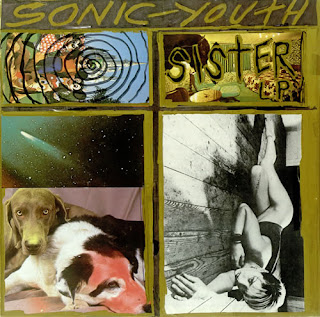Sonic Youth - Sister (Album Review)
Sonic Youth - Sister
(1987)
My copy: 2016 reissue by Goofin’ Records.
Following Evol in ‘86, Sonic Youth released the middle child of their most famous three album run. Though it precedes Daydream Nation (their most famous release of the 80s and potentially of all time) by just one year, Sister is not overshadowed. The production still wasn’t quite slick enough to warrant major praise, but the twisting walls of despondent guitar are at their most effective here while being contrasted by oddly genuine bouts of melody.
“Schizophrenia” is well known for its lyrics, with Kim Gordan playing the titular mentally ill “sister.” While the song predates American pop culture fascination with uncleanliness and disease in the 90s, “Schizophrenia” paints an almost mystical image of the disease with airy open guitars strumming in alternate tunings. The two guitars battle each other, though the tone is kept light until after Gordan’s vocal passage. The building tremolo and drums loosen their grip as anxious dissonant chords creep in. Bending guitar growls cap off what is one of Sonic Youth’s most engaging songs. The snappy lick of “(I Got A) Catholic Block” mimics the sneering vocal melody, birthing one of their all time catchiest verses. The song builds in density, bouncing into dueling chords and spasming drums only to loop back around. Track two is an inverse of sorts to the opening track, as it ends with relaxed, mellow jamming.
A bed of open chords make up the background for Gordan’s spoken delivery on “Beauty Lies In The Eye” which focuses much more on guitar atmosphere than the rhythm section which is almost totally absent. A fractured drum roll passes through, threatening to disrupt the soundscape, instead trailing off into the distance. Guitars bleed all over “Stereo Sanctity” with tom fills that would sound much cooler if they were played on better sounding drums. That said, the percussive performances are fantastic, and the beat snaps from dancey to nervous. The bass is largely quiet across the record, but here it is integral to maintaining the dark mood. “Pipeline / Kill Time” has one of the most frantic drum parts, with unrelenting rolls that only slow later to make room for the vocal recital. The guitars on this track hyperventilate in syncopation, slowly losing steam until they recede into stable breathing. The final section is one of their most eerily calming movements yet, as an insane chirping guitar is backed by the repetition of one final gentle chord.
The tonally conflicted riffing on “Tuff Gnarl’ matches the snotty vocal delivery well, as the second guitar switches from purely textural to brightly melodic. The band uses build ups very frequently to apply pressure, and here the track finally splits at the seams into tearing walls of tremolo. “Pacific Coast Highway” kicks off with guitar that is so percussive that the song borders on industrial music or the dark post-rock stylings of Glenn Branca (whom the band worked with). Gordon pleads and wails over the perverse and metallic instrumentation before the music falls apart into a hazy sort-of guitar solo. Everything then swells as the main passage is reprised, though at a slower tempo. There’s a sort of blues-rock attitude to the guitar soloing on “Hot Wire My Heart” where the vocals are syncopated with sharp riffing. The sing-along chorus maintains the signature Sonic Youth grime, making for a fun twist.
Though the bass is surprisingly elevated in “Cotton Crown” which also features a nice duet between Thurston Moore and Kim Gordon, these final two tracks feel more like rehashes of the groundwork laid by earlier songs. “White Cross” does feature entertaining syncopation, but it mostly leads me to believe that the album was intentionally front-loaded.
Sister is a wild ride, through and through. It makes a near perfect companion to '86’s Evol with both featuring some of their best work. It feels as though by taking the best tracks from both Evol and Sister, you could create a work that outshines much of their catalog. Where they stand, the '86 and '87 albums are still truly great examples of creative song structures backed by evocative narratives and unusual tones. Sonic Youth are well known for utilizing bizarre tunings, and their curious approach to crafting a song balances between utterly unhinged and totally composed. Sister provides a great balance between a more mellowed out Sonic Youth and their early, more chaotic days.




Comments
Post a Comment